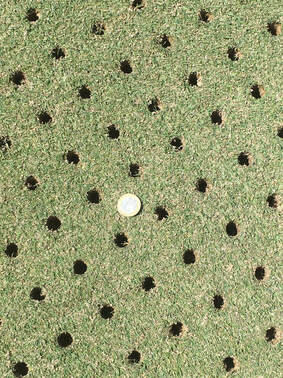Aeration (hollow tining)
|
Aeration (hollow tining)
Aerification achieves three important objectives. It relieves soil compaction, it provides a method to improve the soil mixture around the highest part of a green's roots and it reduces or prevents the accumulation of excess thatch. Like so many things, the quality of a good putting green is more than skin deep. In fact, the condition of a green has a lot to do with what goes on below the surface. In order for grass to grow at 3/16-inch, it must have deep, healthy roots. Good roots demand oxygen. In good soil, they get the oxygen from tiny pockets of air trapped between soil and sand particles. Over time, the traffic from golfers' feet (as well as mowing equipment) tends to compact the soil under the putting green - particularly when the soil contains a lot of clay. When soil becomes compacted, the air pockets on which the roots depend are crushed, and the roots are essentially left gasping for air. Without oxygen, the grass plants become weaker and will eventually wither and die.
Older greens often are constructed of soils with significant amounts of silt, clay and fine organic particles that are prone to compaction. Filling aerification holes with sand improves drainage and resists compaction. The periodic introduction of sand to a green's top layer can over time, avoid or postpone expensive rebuilding or renovation of greens. Finally, growing of turf adds to a layer of organic matter on the surface. This layer, called thatch, is an accumulation of dead stems, leaves and roots. A little organic matters makes for a resilient green, but too much invites diseases and insects. Topdressing with sand can prevent thatch buildup, and aerification is one of the best ways to reduce an existing layer and prevent an excess of thatch from becoming established. Other aerification techniques use machines with "tines" or knives that simply poke holes through the soil profile. A new technique even uses ultra high-pressure water that's injected through the soil profile to create small holes that relieve some compaction but heal quickly. These techniques are also used by our green staff to help maintain the quality of our putting surfaces. |
|






